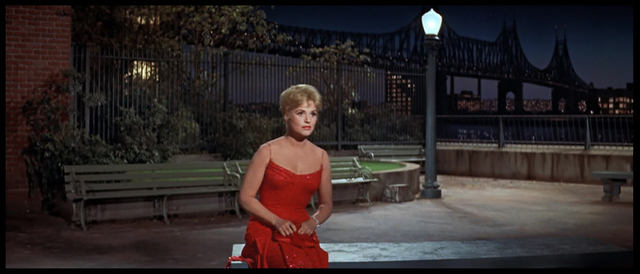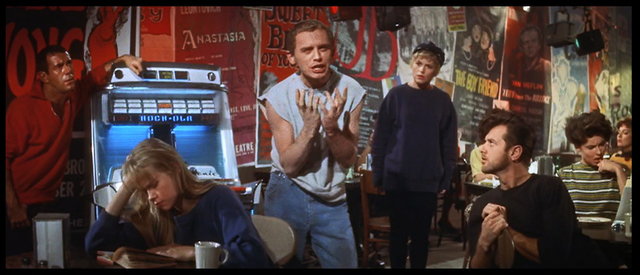The end, when it came for the Freed Unit at MGM, wasn't a bang but a respectable flop. It probably would have been better if Arthur Freed had rolled up his musical production team at the studio two years earlier, when he had a verifiable hit on his hands with Gigi, but it's hard to go out when you're on top.
Bells Are Ringing was a Broadway hit, opening late in 1956 and running for two years with Judy Holliday in the lead role for almost the whole time. Written by Betty Comden and Adolph Green with music by Jule Styne, it was an automatic candidate for a screen adaptation by the Freed Unit. On its way to the big screen it lost director Jerome Robbins and choreographer Bob Fosse, but gained Freed veteran Vincente Minnelli as director and Dean Martin as Holliday's co-star, still rebuilding his career after splitting with his comic partner Jerry Lewis.
In hindsight it's difficult to miss the hints that the film is about things changing and ending, starting with the title credit sequence, full of shots of Manhattan buildings being demolished during the city's first great post-war "urban renewal," a sequence that ends with a lone brownstone sitting in an empty lot littered with debris – the offices of Susanswerphone, a telephone answering service owned by the eponymous Sue (Jean Stapleton).
Before answering machines, answering services were the low tech cutting edge way to make sure you never missed an important phone call – crucial for freelancers and small businesses without receptionists, though in the arch little advert that opens the film, Susanswerphone's target clients seem to be young ingénues in the big city waiting for model bookings, auditions, dates, marriage proposals and inheritances.
Holliday plays Ella, a timid woman who has emotionally chained herself to the basement switchboard, finding something like fulfillment by conspiring to improve the lives of Susanswerphone's clients, taking on different roles with each one, matchmaking and scheduling and providing support services above and beyond her job description. She has, in essence, become social media incarnate, a one-woman suite of apps.
Most cherished among her clients is Jeffrey, a playwright recently separated from his writing partner, depressed and out of confidence in his talent. As played by Martin he's a bibulous playboy, drinking his way through blown deadlines – hardly a stretch for the singer and actor who was already turning himself into America's charming drunk uncle.
The heavy – if there really is one – is Inspector Barnes, a cop convinced that Susanswerphone is a call girl service, eager to score a promotion by busting the whole sleazy operation. A classically inept comic flatfoot, he manages to overlook the bookmaking operation being run by Sandor, the impresario boyfriend of Sue, fronting as a mail order classical music label.

It's a New York movie, where everyone is twitchy and tightly wound, their neuroses on public display. The teeming city is filled with agoraphobes like Martin's Jeff, and Minnelli's masterful control of the camera and crowds of extras on MGM's backlot New York streets conveys that sense of isolation in a mob, surging forward without making eye contact, shocked by a friendly gesture. In spite of it all, Holliday's Ella has carved out a vital but anonymous place amidst it all, helping and guiding and making connections while remaining faceless, a dubious accomplishment she tentatively celebrates in her first musical number, "It's A Perfect Relationship."
It's hard to imagine the film without Holliday, whose appeal was so peculiar and unique from the moment she nearly stole Adam's Rib from Katharine Hepburn and Spencer Tracy in 1949. That role led to Billie Dawn in Born Yesterday a year later, another George Cukor film that won her an Oscar and made her a star, but also typecast her as the dumb outer borough blonde with unexpected depths – a role she was basically still playing in Bells Are Ringing.

While Dean Martin does his customary job of effortlessly supporting whomever he shares a screen with, the film rests squarely on the shoulders of Holliday, who was as insecure in real life as the characters she played. In Hugh Fordin's MGM's Greatest Musicals: The Arthur Freed Unit, a definitive history of Freed's work at the studio, we learn that Holliday begged to be released from the picture that was built around her performance, worrying that she was gaining too much weight and – unbelievably – was wrong for the part. She was even willing to reimburse Freed and MGM for expenses on the film to date so they could recast the part.
Holliday was in poor health throughout the production, suffering from laryngitis and kidney and bladder infections. A suitcase fell on her leg, and she was left with skin burns after a scene in which the clumsy Ella accidentally sets the back of her dress on fire on a date in a fancy restaurant. What almost no one knew was that she was suffering a relapse of the throat cancer that would kill her five years later.
There was really no other actress like Judy Holliday. She was a movie star without the glamour, famous for playing regular people and underdogs in films like The Marrying Kind, The Solid Gold Cadillac and It Should Happen to You. She was a singer with a voice no one would call virtuoso – raspy and tentative, uncertainly hovering over occasional notes, it was the sort of voice that would usually get dubbed on the soundtrack by a ringer like Marni Nixon, except that it was so integral to Holliday's appeal.
Holliday and her voice deliver with "The Party's Over," the best song in Bells Are Ringing, and a highlight of the collaboration of Comden, Green and Styne. Sung on a studio backlot recreation of Sutton Place on the Upper East Side, with the Queensboro Bridge in the background, it's the low point for Holliday's Ella, the moment when she realizes that neither she nor Melisande Scott, the persona she created to inspire and motivate Jeff to finish his play, are at home in the world of name-dropping theatre and society swells in evening gowns and black tie where successful Broadway playwrights live.
At this point it's worth talking about The Subterraneans, the film that the Freed Unit was making around the same time as Bells Are Ringing. Based on Jack Kerouac's follow up to On The Road, it was a story about bohemian life in San Francisco's North Beach, starring Leslie Caron, George Peppard, Janice Rule and Roddy McDowall, with a soundtrack and onscreen performances by real jazz musicians such as Carmen McRae, Art Pepper, Art Farmer and Gerry Mulligan – Judy Holliday's boyfriend, who would be given a cameo in Bells Are Ringing as Ella's blind date.
Like nearly any Hollywood film about beatniks, it's supposed to be terrible, but I can't confirm that for you myself since it's nearly impossible to see – it was as rare on the rep cinema circuit as it is on cable TV today, and Warner Bros., who own most of MGM's archives, have never seen fit to reissue it on disc. Freed and his team apparently set out to portray Kerouac's milieu with the best of intentions, but the altering, editing and censoring of the story began the moment they changed the female lead from African American to a Frenchwoman played by Caron, unwilling to centre their film around an interracial romance.

Bells Are Ringing had its own beatnik subplot, featuring Frank Gorshin as a struggling actor whose method fundamentalism obliges him to commit to a nonstop imitation of Marlon Brando. Ella dresses up in beat drag to head down to the Village and convince him to drop the dungarees and sweats for a suit when he auditions – a move that nets him a role in Jeff's play, The Midas Touch.
Hollywood spoofs of beatniks were probably as cornball then as they are today, but that doesn't mean that the beat generation were immune to satire, and the scene showcases a facet of Holliday's talent as a comedienne that would sadly never be seen in movies again. She takes the thin material and – with Gorshin as her foil – mines it for all the comic potential you could ask for in coffee house comedy. In any case, we haven't really advanced much past the standard set by this scene today, in shows like Amazon's The Marvellous Mrs. Maisel, which set much of its first season in the pre-Beatles beatnik Village, while filling its soundtrack with Broadway songs from the era.
There's an abiding undercurrent of nostalgia for the late '50s and early '60s today – the era of Ike and Camelot, of postwar economic miracle, early rock and roll, the last moment when jazz was adjacent to the mainstream, and the interregnum between the Korean police action and Vietnam. It erupted briefly into the mainstream with the first seasons of Mad Men, and continues with Mrs. Maisel, a fond portrait of a world built for adults, with better clothes, bigger cars and affordable housing. Some of it is probably Boomer sentimentality, but that doesn't explain the appeal among people born years afterward.
Watching movies made at the time, however, it's hard to ignore intimations that things weren't nearly as complacent as we thought, and that some big changes, good and bad, were both overdue and on their way. The diminishing appetite for widescreen Technicolor movie musicals was one sign, and while we regret their loss today, the fact is that stories and songs that could run on Broadway for years only lasted for weeks in movie theatres. Audiences were apparently moving on, though why and to where were questions we still argue about today.
Arthur Freed would make one more picture for MGM under his new contract – Light in the Piazza, a drama starring Olivia de Havilland, George Hamilton and Yvette Mimieux, shot on location in Italy and a flop in the theatres when it was released in 1962. He would spend the rest of the decade trying and failing to make a big budget musical tribute to Irving Berlin.
Along the way Freed would acquire properties for MGM – Camelot and My Fair Lady among them – that the financially troubled studio would sell on to other producers like Jack Warner. He took a leading role producing the annual Oscars awards shows, but he finally left the studio and his office there, with its living room, library and music room, in 1970, as Kirk Kerkorian, the new owner of MGM, began selling off or destroying its archives of props, costume, scripts and sets and demolishing parts of the backlot. The age of the Hollywood musical was finally over.
Mark Steyn Club members can let Rick know what they think by logging in and sharing in the comments below, as access to the comments section is one of many benefits that comes along with membership in the Mark Steyn Club.

